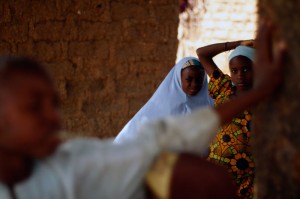Zaria
Amina told us last night she’d come by our hotel (the Catholic Social Centre, a bargan 3900N for a room with a fan, occasional electricity, a spigot, and a bucket for bathing) in the morning to pick us up (or actually, just “pick us” as people here say, no need for the “up”).
She texted when she was on her way, and despite Miranda’s desire not to, we snuck out for ten minutes of quick Internet access while waiting. This allowed me time to post my backdated blog entries, and rapidly check my e-mail (but not really reply to anything).
Amena ‘picked us’ and we headed to do some quick errands with her before Zaria. The drive to Zaria was picturesque, again in the “great American plains” sort of way; grasslands peppered with boulders and the occasional tiny mountain. After so many months of jungle-covered rolling hills in Ghana even the smallest bit of topography seems striking.
 Zaria has a feeling of being old, steeped in tradition. The original part of the city is still walled off, it’s probably older than a millenium, although I have no idea as to its exact age. We drove through streets choked with robed pedestrians, passing temples and narrow alleyways, barely another car in site. Eventually we found the Zaria Cold Store and were invited inside to see freezers full of fresh vaccines, power courtesy of a large petrol generator in a cinderblock building adjacent to the Store.
Zaria has a feeling of being old, steeped in tradition. The original part of the city is still walled off, it’s probably older than a millenium, although I have no idea as to its exact age. We drove through streets choked with robed pedestrians, passing temples and narrow alleyways, barely another car in site. Eventually we found the Zaria Cold Store and were invited inside to see freezers full of fresh vaccines, power courtesy of a large petrol generator in a cinderblock building adjacent to the Store.
Amena dropped us with her contact in Zaria and we left for the Health Department, to do the official notification of our visit before we could find measles cases. The head of the dept informed us there were no cases at his clinics today but we could check the General Hospital, which reports to the state government and not him.
At the GH we found a handful of cases, mostly with pnuemonia and/or malnourishment. Measles damage usually comes as a complication of the synergy between measles and other issues, often vitamin A deficiency. There were two cases with eye complications; measles is the leading cause of blindness in the developing world. The last case we saw, which was the second with eye complications, will likely result in permanent blindness. The mother sat sullenly, quietly answering our questions and then lingering in silence as I thanked her in Hausa for speaking with us and letting us film her child.
It was especially hard to encounter that last case — any admitted measles cases at a hospital will mean severe complications, but most of the children we were seeing would make a full recovery after nourishment and drugs. Here in this case was a kid who would probably never see again, and all of these complications for lack of a nickel’s worth of vitamin A. This is the exact reason we’re making this film: the world must work harder to reach more children and make these simple, inexpensive, and effective interventions.
Back at the Zaria Cold Store a coworker of Amena’s told us of an outbreak of measles going on in his LGA (Local Government Area) so we’re going to head over there early tomorrow for the first day of Child Health Week to observe vaccinators and health workers. At the hospitals and clinics it’s hard to get a sense of the scope of the outbreak because the only cases we see are the ones admitted for inpatient treatment (a small percentage) or the outpatient cases that have literally just arrived. Hopefully tomorrow will hold some door-to-door possibilities to get a sense of the scope of things on the ground.
We drove the hour back to Kaduna, Amena bought us some Fan Ice (what passes for ice cream in West Africa), and dropped us at our hotel. Miranda promptly passed out, and I’m knee deep in backing up footage, as always … 14 minutes left on tonight’s transfer and then I can sleep for a few hours before we do it all again.








